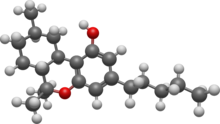Hexahydrocannabinol
 | |
 | |
| Legal status | |
|---|---|
| Legal status |
|
| Identifiers | |
| |
JSmol) | |
| |
| |
Hexahydrocannabinol (HHC) is a
HHC is a
Pharmacology
HHC has 2 diastereomers that only differ by the orientation of the 9-methyl group, unlike D9-THC and D8-THC which have the double bond position next to the 9-methyl group that prevents this. The 9-methyl group orientation is believed to be important for cannabinoid binding affinity.
Research has found 9R-HHC to have a binding affinity of 15nM ± 0.8nM at CB1 and 13nM ± 0.4nM at CB2, while 9S-HHC has a binding affinity of 176nM ± 3.3nM at CB1 and 105nM ± 26nM at CB2.
The same study found Delta-9-THC to have a binding affinity of 15nM ± 4.4nM at CB1 and 9.1nM ± 3.6nM at CB2. 9R-HHC has a lower selectivity for CB2 (1.2x) compared to D9-THC (1.6x).
9R-HHC has an EC50 of 3.4nM ± 1.5nM at CB1 and 6.2nM ± 2.1nM at CB2 while 9S-HHC has an EC50 of 57nM ± 19nM at CB1 and 55nM ± 10nM at CB2. The same study found D9-THC to have an EC50 of 3.9nM ± 0.5nM at CB1 and 2.5nM ± 0.7nM at CB2.
The EC50 shows 9R-HHC has a lower selectivity for CB2 (0.55x) compared to THC (1.5x). HHC has been typically described as weaker than Delta-9-THC in psychoactive effects. HHC produces 11-Hydroxyhexahydrocannabinol and 8-Hydroxyhexahydrocannabinol among others as a metabolite which may contribute to its overall effect.[7][8]
Chemistry
Several research groups have successfully synthesized (+)-HHC and (-)-HHC using citronellal and olivetol,[9] as well as other related compounds.[10] HHC and related hydrogenated cannabinoid epimers were elucidated using various NMR spectroscopic techniques (ie, NOSY, COSY, 1H) and the diastereomers were isolated using LC-MS and SCFC.[11] While similar compounds have previously been identified in cannabis,[12] hexahydrocannabinol itself has rarely been isolated from the plant. The de Las Heras group in 2020 took lipid extract from Cannabis sativa seeds and discovered 43 cannabinoids in the crude extract; one of them being hexahydrocannabinol. It has two diastereomers at the methyl (9) position. HHC is typically made from CBD. There are no double bonds in the cyclohexyl ring like D8/D9 have—they have been removed from the structure and hydrogens have been added to the compound.[13][14]
Several structurally related HHC analogs have been found to be naturally occurring in Cannabis including cannabiripsol,[15] 9α-hydroxyhexahydrocannabinol, 7-oxo-9α-hydroxyhexa-hydrocannabinol, 10α-hydroxyhexahydrocannabinol, 10aR-hydroxyhexahydrocannabinol and 1′S-hydroxycannabinol,[12] 10α-hydroxy-Δ(9,11)-hexahydrocannabinol and 9β,10β-epoxyhexahydrocannabinol.[16]
HHC itself has been found as a degradation byproduct of THC in a similar way that Cannabinol and Delta-8-THC can be formed by the Cannabis plant from Delta-9-THC degradation. The degradation of D9-THC that forms HHC is the reduction of the double carbon bonds that would typically make up the delta isomer position on THCs structure.[17][18]
Delta-9-THC was discovered to partly metabolize into 11-Hydroxy-THC and alpha,10 alpha-epoxy-hexahydrocannabinol along with 1,2-epoxy-hexahydrocannabinol.[19] Cannabidiol was discovered to partly metabolize into 9α-hydroxy-HHC and 8-hydroxy-iso-HHC inside the body. In the presence of alcohol, the methoxy or ethoxy analogs such as 9-methoxy-HHC, 10-methoxy-HHC, 9-ethoxy-HHC and 10-ethoxy-HHC can be formed.[20]
Hexahydrocannabinol should not be confused with the related compounds 9-Nor-9β-hydroxyhexahydrocannabinol (9-Nor-9Beta-HHC) or 9-Hydroxyhexahydrocannabinol (9-OH-HHC) or 11-Hydroxyhexahydrocannabinol (11-OH-HHC and 7-OH-HHC), all of which have also sometimes been referred to as "HHC".[citation needed]
Legality
The ANSM announced the ban (production, sale and use) of HHC and two of its derivatives, HHC-acetate (HHCO) and hexahydrocannabiphorol (HHCP), on French territory from June 13, 2023.[21][22]
In the United Kingdom, HHC would likely be considered illegal under the Psychoactive Substances Act 2016.
Several European countries (Denmark, Belgium) also recently[when?] banned the sale of HHC.[22][verification needed]

In Austria, HHC has been banned since 23 March 2023 due to the amendment of the New Psychoactive Substances Ordinance (known in German as Neue-Psychoaktive-Substanzen-Verordnung or NPSV).[23]
HHC has been banned in Sweden since July 11, 2023, and in Italy since July 28, 2023.[24]
HHC has been banned in Lithuania since November 23, 2022.
HHC has been banned in Slovenia since November 15, 2023.[25]
On March 1, 2024, Deputy of the Moscow City Duma
HHC has been banned in Czechia since March 6, 2024.[27]
The German expert committee for narcotics suggested that HHC be added to the annex of Novel Psychoactive Substances Act (NpSG) in a meeting on December 4, 2023.[28] This recommendation has to date not been enacted by the German government, although this is likely to occur in the first half of 2024.
See also
- 8-Hydroxyhexahydrocannabinol
- 11-Hydroxyhexahydrocannabinol
- 7,8-Dihydrocannabinol
- Cannabinol
- 9-Nor-9β-hydroxyhexahydrocannabinol
- 9-Hydroxyhexahydrocannabinol
- H4-CBD
- Hexahydrocannabihexol
- HU-243
- Canbisol
- Delta-8-THC
- Delta-10-THC
- Delta-11-THC
- Tetrahydrocannabiphorol
- THC-O-acetate
- Delta-6-Cannabidiol
References
- S2CID 34267092.
- S2CID 211113472.
- .
- .
- doi:10.2810/852912.
- S2CID 259046522.
- ^ https://pubs.acs.org/doi/10.1021/acschembio.3c00254
- ^ https://analyticalsciencejournals.onlinelibrary.wiley.com/doi/abs/10.1002/dta.3519
- .
- S2CID 209343301.
- ISSN 1934-578X.
- ^ PMID 26093324.
- PMID 1680642.
- S2CID 25827210.
- S2CID 19529732.
- PMID 26000707.
- PMID 4752104.
- PMID 22740.
- PMID 1347001.
- PMID 32503116.
- ^ "Cannabis : le HHC sera interdit en France à partir de mardi". Le Monde.fr (in French). 2023-06-12. Retrieved 2023-06-12.
- ^ a b "Actualité - L'ANSM classe l'hexahydrocannabinol (HHC) et deux de ses dérivés sur la liste des stupéfiants". ANSM (in French). Retrieved 2023-06-12.
- ^ "Office for Tobacco Coordination - News and Product Warnings - AGES - Hexahydrocannabinol (HHC), new regulation in the NPSV". Österreichische Agentur für Gesundheit und Ernährungssicherheit. Retrieved 7 February 2024.
- ^ "Gazzetta Ufficiale". www.gazzettaufficiale.it. Retrieved 2023-08-06.
- ^ "eUprava - Predlog predpisa". e-uprava.gov.si. Retrieved 2023-12-24.
- ^ https://besedina.moscow/messaging/728
- ^ "Začíná platit zákaz držení a prodeje produktů s HHC, HHC-O a THCP". seznamzpravy.cz/. Retrieved 2024-03-06.
- ^ "Sachverständigenausschuss für Betäubungsmittel nach § 1 Abs. 2 BtMG und Neue-psychoaktive-Stoffe nach § 7 NpSG". www.bfarm.de (in German). Retrieved 2024-01-15.
